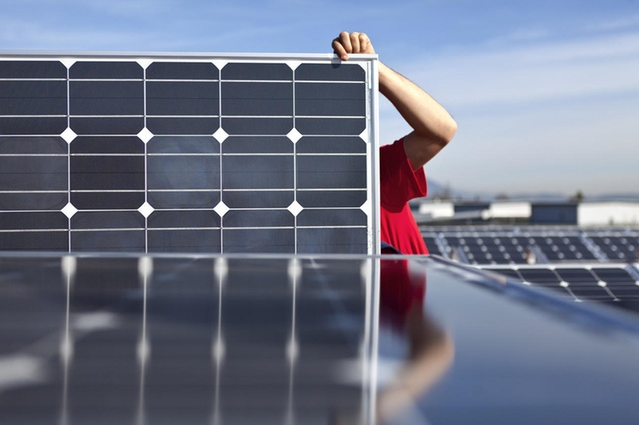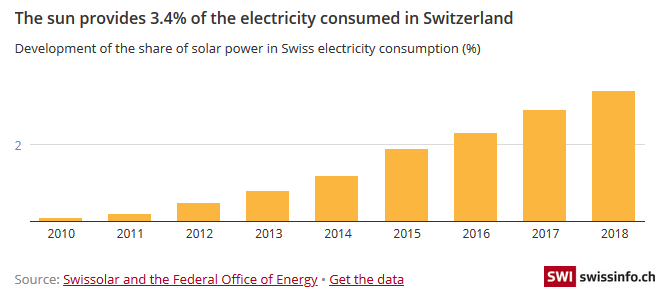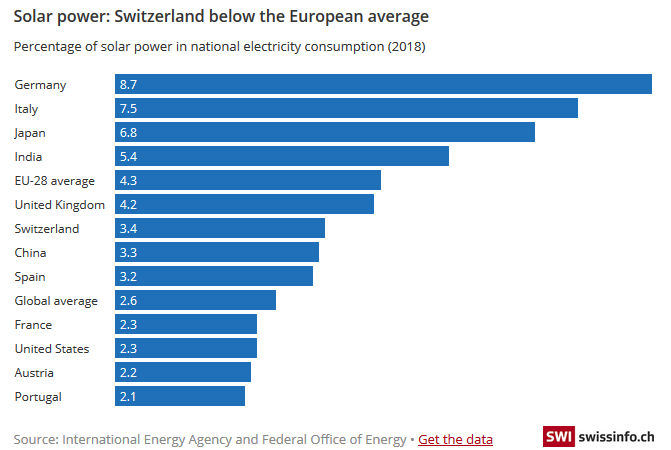|
Solar energy is the main source of renewable energy in Switzerland, after hydroelectric power. But its potential is far from being exploited, according to industry experts. In 1982 Switzerland became the first country in Europe to connect a photovoltaic plant to the electricity network. Ten years later it inaugurated what at the time was the continent’s largest solar power station. And in 2015, the world’s largest off-grid solar panel system on the roof of a sports stadium started operating in Biel. Today, Switzerland is one of the most innovative countries when it comes to solar energy, as witnessed by the ground-breaking Solar Impulseexternal link and PlanetSolarexternal link projects. However, solar power is struggling to break through at a national level. |
 In 2018, solar power provided 3.4% of the electricity consumed in Switzerland. (Keystone / Marti |
How much electricity is produced using solar?There are around 85,000 photovoltaic installations in Switzerland, with an overall power of 2,172 megawatts (at the end of 2018), according to the industry association Swissolarexternal link. The panels cover 13 million square metres – the equivalent of 2,000 football pitches. In 2018, solar provided 3.4% of the electricity consumed in Switzerland. The sun is the country’s main source of renewable energy after hydroelectric, which covers 60% of energy needs. The share of solar power has constantly increased in Switzerland since 2010. |
The sun provides 3.4% of the electricity consumed in Switzerland |
How does Switzerland compare internationally?The production of solar power in Switzerland is higher than some Mediterranean countries such as Spain and Portugal, but it is below the European average. Interestingly, in Switzerland almost all photovoltaic panels are mounted on buildings, while in neighbouring countries they are found in fields. This can be explained by the lack of adequate areas, the expensive authorisation process and reservation among the public in Switzerland. |
Solar power: Switzerland below the European average |
How has the sector evolved?
The solar industry in Switzerland generates an annual turnover of around CHF865 million ($875 million) – CHF750 million for photovoltaics and CHF115 million for solar thermal systems (which produce heat).
Last year the construction of solar installations increased in particular among single-family homes (+17% compared with 2017) and multi-family homes (+47%), Swissolar said.
This trend has been helped by a drop in the cost of installations and the development of integrated photovoltaics. Today, panels have become an element of roof coverings and façades, which facilitates their use.
However, when it comes to industrial or artisan buildings, Swissolar notes a stagnation and even a decrease for agricultural buildings. It says this contraction is due to gaps in the current system for making solar power attractive.
How can solar power be made more attractive?
In Switzerland every consumer contributes to the funding of photovoltaics and other renewable energies via an additional charge on their electricity bill, which legally cannot exceed CHF0.023 per kilowatt hour. The proceeds allow the financing of solar installations – even if demand currently exceeds the available resources.
If someone wants to install photovoltaic panels, the government will cover around 30% of the estimated cost of the installation, says Mauro Caccivio, an expert in photovoltaic systems at the University of Applied Sciences and Arts of Southern Switzerland (SUPSI).
What is the potential of solar energy in Switzerland?
The production of solar electricity in Switzerland is 1.9 terawatt hours a year (at the end of 2018).
If solar panels were installed on the roofs and façades of every building suitable for using the power of the sun, Switzerland could produce around 67 terawatt hours a year, according to the Federal Office of Energyexternal link.
If one also takes into consideration the roofs of carparks and the surfaces of roads and Alpine spaces – for example, ski stations – an additional 15 terawatt hours could be added, Swissolar says.
The organisation points out that the development of solar and other forms of renewable energy would permit Switzerland to have 100% clean energy by 2050.
Full story here Are you the author? Previous post See more for Next postTags: Business,newsletter































1 comments
Stefan Wiesendanger
2019-11-08 at 13:59 (UTC 2) Link to this comment
A solar panel would generate 3 times the electricity when placed in Spain or in Tunisia rather than in Switzerland. Solar in Switzerland is a sin against the economy and against the environment.
To present an analogy: if one contends that transportation of food over long distances is bad for the environment, one may come up with a plan for Switzerland to become self-sufficient in the provision of bananas. This is certainly possible but would come at a higher economical and at closer examination also environmental cost.
There is an economical and also ecological reason why bananas are farmed where they grow naturally. There is a reason why hydropower plays a prominent role in Switzerland and Sweden, but not in Denmark or the Netherlands. There is a reason why PV panels that are costly to make should be placed in regions that are best suited for it. Just imagine: 3(!) times the output for the same use of capital (for the business-oriented reader), or the same environmental footprint (for the environmentally-minded).
Just because you can become self-sufficient with solar power doesn’t mean it’s not wasteful.